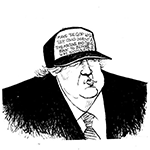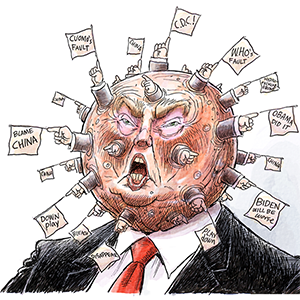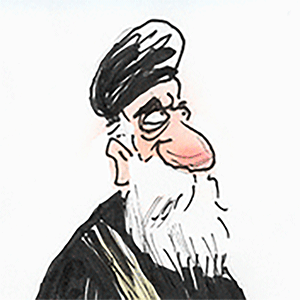Commentary: How will Syria evolve under new leadership?
Published in Op Eds
Ahmad al-Sharaa, formerly known as Abu Mohammed al-Jolani, might be one of the most popular people on the planet right now. Nearly a month after his militant group Hayat Tahrir al-Sham (HTS) shocked the world by ending the Assad family’s 53-year reign of power in Syria, the onetime detainee in a U.S. military prison in Iraq is now the de facto head of state in Syria. And to the victor go the spoils, including a long list of foreign delegations eager to meet him.
Diplomats are tripping over themselves to score a sit-down with Sharaa, who not too long ago was viewed in Washington and European capitals as the head of an al-Qaida-affiliated terrorist organization.
British officials made contact with HTS shortly after Syrian President Bashar Assad fled to Russia. The French sent a delegation to Damascus and are preparing to reopen their embassy in the Syrian capital. The European Union aims to do the same thing. The top U.S. diplomat responsible for the Middle East had a short session with Sharaa last week.
Syria’s neighbors in the region aren’t far behind — the Turkish, Qatari and Jordanian foreign ministers had meetings with the HTS chief in a bid to press their priorities and determine how the new authorities intend to govern a country devastated by more than 13 years of civil war.
It’s unlikely Sharaa has all the answers right now. While the victory against Assad’s forces was a triumph that HTS and other armed opposition groups were dreaming about for years, the jihadist-turned-statesman is now stuck with a lengthy to-do list.
Fighting is one thing; governing is another. This is particularly true when the thing to be governed is a nation without sovereignty and a decent economy. The Assad family was as corrupt as it was repressive, personalizing all of its institutions, stripping the state of whatever assets it had and turning Syria into one of the world’s most efficient producers of illegal narcotics — all to pad the family’s wealth. Meanwhile, about 90% of the Syrian population lives below the poverty line.
Syria may not have to deal with the hated Assads anymore, and it is no longer at war, but it’s not exactly at peace, either. Militias such as HTS, the Turkish-backed Syrian National Army and local armed units in Syria’s south coordinated with each other to oust a mutual adversary, but it’s unknown whether they will be able to cooperate with one another in building a future Syria.
The Syrian Democratic Forces, a U.S.-supported, Kurdish-led militia in the northeast, is arguably Syria’s most powerful armed actor and is highly unlikely to disarm without big concessions, including a decentralized Syrian political order. This, of course, is precisely what HTS wants to avoid given that it’s now the new overlord of Damascus.
Syria won’t be immune to foreign machinations, either. While U.S., Turkish, Saudi, Qatari, Israeli and European officials are predictably trumpeting respect for Syria’s territorial integrity, foreign powers have reason to influence what’s going on there. The Europeans, for instance, are talking about keeping sanctions on the Syrian economy unless the post-Assad administration closes Russia’s military bases and scrubs Syrian society of all Iranian influence.
The Gulf states, which tried to persuade Assad to downgrade his ties to Iran, will seek to capitalize on the biggest change in the Middle East’s regional balance of power since the U.S. invasion of Iraq in 2003. Turkey, which had unofficial ties with HTS for years when the group governed the Syrian province of Idlib, is now pushing Sharaa to get tougher on the very Syrian Kurdish groups the United States supports.
Speaking of the United States, it’s back to the drawing board. Washington didn’t have great relations with Syria under the Assads. During President Hafez al-Assad’s long reign from 1971 to 2000, Syria was essentially a client state of the Soviet Union and a regional destabilizer, occupying next-door Lebanon for decades.
Under son Bashar, the country turned into a key node of Iran’s so-called “axis of resistance,” allowing the Islamic Revolutionary Guard Corps to use Syrian territory to transport weapons to the Lebanese militant group Hezbollah. During the U.S. occupation of Iraq, Assad turned Damascus into a gateway for foreign jihadists who wanted to fight the Americans next door.
With Assad now in Russia, Washington has a blank slate. President Joe Biden is on his way out, so how the U.S. ultimately responds will be determined by Donald Trump once he is inaugurated. Even so, senior U.S. officials have wasted no time trying to ingratiate themselves with Sharaa, who until last week had a $10 million FBI bounty on his head for terrorism offenses.
Barbara Leaf, the State Department’s top Middle East official, spoke with him in Damascus last week to outline what Washington expects of the new authorities: The Syrian government must be inclusive and representative, ethnic and religious minorities need to be respected, and Syria must destroy all of the chemical weapons of the old regime. The new Syria must also combat terrorism in all its forms and transform itself into a benevolent state that doesn’t threaten its neighbors.
Geir Pedersen, the United Nations’ special envoy for the Syrian conflict, has talked about a future of hope now that a post-Assad transition is underway. That’s all well and good. But we’re still a long way from that rosy scenario.
_____
Daniel DePetris is a fellow at Defense Priorities and a foreign affairs columnist for the Chicago Tribune.
_____
©2024 Chicago Tribune. Visit at chicagotribune.com. Distributed by Tribune Content Agency, LLC.




























































Comments